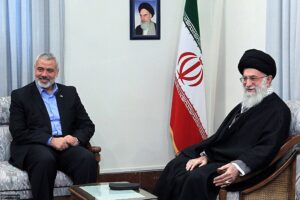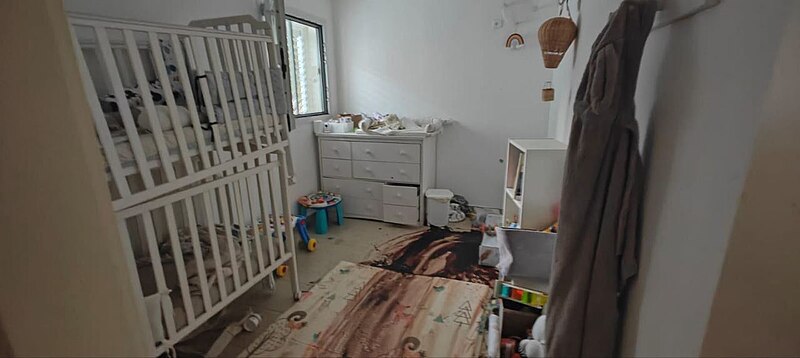Bayard & Holmes
~ Jay Holmes
The first question that many people asked once they became aware of the October 7 Hamas terror attack on Israel was, “How could Israel allow themselves to be surprised by a Hamas terror attack?” The second question most of us were asking was, “How could Hamas leadership not know that such savagery would compel Israel to a major invasion of Gaza?” Hamas’s complete lack of foresight seems obvious enough. Answering why it suffered this lack is far more complex than it might seem on the surface. We offer our analysis for debate. We accept that not everyone will agree with us, and we invite everyone to take their best shot at this round of post-catastrophe armchair generalship.
In Part One: What’s Happened So Far, we have a timeline of the attacks and responses up to December 4. In Part Two: Israel’s Constraints and Failures, we try to shed light on the question of how Israel was taken by surprise. In this Part Three, we will consider who Hamas’s internal decision makers and major influence wielders might be. It’s easy enough to assume that Hamas’s leadership had the lion’s share of the blame for not seeing the Israeli freight train speeding down that policy hill toward Gaza. In the case of Hamas, though, even that simple and obvious assumption is less certain than it might seem to be on the surface.
Ismail Haniyeh, Chairman of the Political Bureau

Ismail Haniyeh with Iran’s Supreme Leader Ali Khamenei
Image from Ali Khamenei Website
Wikimedia Commons, CCA 4.0 Intl
Hamas has been loud and consistent in its anti-Israel genocidal dogma since it announced its formation in 1987. Western observers might take that as evidence of unanimity and equanimity within Hamas. However, unlike the situation in most political systems, Hamas’s leadership does not all reside in the territory that it claims as home.
Hamas’s top leader, Ismail Haniyeh, holds the title of “Chairman of the Political Bureau.” According to Hamas, he is the group’s top leader. He has chief authority for Hamas’s foreign relations, and he is responsible for overseeing Hamas and seeking funding for the organization. Since Hamas relies heavily on foreign funding, Haniyeh’s job is critical to its survival. After all, a bunch of terrorists with no money for manufacturing missiles and suicide vests is not going to get much done.
Haniyeh does not live in Gaza. Until a week ago, he lived in Qatar, and, unlike the average person in Gaza, Haniyeh lived in luxury. Since he manages foreign funds ostensibly destined for Gaza, he can afford to. At this point, he has disappeared without taking his cell phone.
Deputy Chairman Saleh “Sally” al-Arouri, Theoretical Second In Command

Saleh “Sally” al-Arouri
Russia-Hamas Meeting 2022
Image by Council of the Federation of the Federal Assembly of the Russian Federation
Wikimedia Commons, CCA 4.0 Intl
Haniyeh’s theoretical second in command is Deputy Chairman Saleh al-Arouri, or “Sally,” as he is known among the workers in the top brothels in Lebanon. Sally also resides outside of Gaza, principally in Lebanon but sometimes in Qatar. Like his boss, Haniyeh, Sally lived in comfort until last week, when, like his boss, he disappeared without taking his phone.
Sally’s job is similar to any other “vice” position in politics. He is there to take over if Israeli agents catch up to Haniyeh, and in the meantime, he is the head scapegoat for any Hamas foreign policy problems. Oddly enough, Sally is simultaneously also theoretically in charge of Hamas military operations in the West Bank. This particular wrinkle in Sally’s professional terrorist life leaves him simultaneously striving for somewhat conflicting goals.
Hamas exercises dictatorial powers in Gaza. It does not have such complete power in the West Bank. In the West Bank, Hamas has competition from various smaller terrorist groups, such as the old Islamic Jihad, the radicals within what remains of the “Palestinian Authority,” and various and sundry Islamic jihadist upstart groups. As a result, what is best for Hamas in Gaza on any given day is not always what is best for Hamas in the West Bank.
Yahya Sinwar, Theoretical Leader of Hamas in Gaza

Yahya Sinwar
Image by Hadi Mohammad
Fars Media Corporation
Wikimedia Commons, CCA 4.0 Intl, No Higher Resolution
Inside of Gaza, Yahya Sinwar. Yahya, known to some as Yehya, is the theoretical big boss. The problem is that not every Hamas member in Gaza agrees that he is the local boss.
Sinwar was a Gaza terrorist long before the formation of Hamas. He is believed to have a paranoid personality, and much of his occupation as a terrorist has been dedicated to weeding out disloyal members of the organization. He spends a fair amount of time securing his authority, as well as his survival — something he has been doing since his high school days in Gaza. As a result, Sinwar is skilled at making and aggravating enemies, and his constant elimination of perceived threats has made him unpopular among the lower ranks. He can never fully trust anyone under his authority, and nobody under his authority can fully trust him.
According to Yousef al-Mansi, Hamas’s former Communications Minister for Hamas and propaganda specialist, Sinwar leads the most radical faction of Islam, he suffers delusions of grandeur, and he is a madman to have conducted the October 7 attack. Al-Mansi says Hamas is splintering, and that many of Hamas’s adherents in Gaza do not agree with Sinwar. Al-Mansi claims there have been 17,000 deaths so far, and that most of the people of Gaza blame Sinwar for those deaths and no longer support him.
It is worth noting that al-Mansi was in the custody of Shin Bet when he said those things; however, there were signs of tension between him and Sinwar before he was in Israeli custody.
Muhammad Deif and the Tangled Web
Sinwar’s technical second in command, who is not actually subordinate, is Hamas’s military leader in Gaza, Muhammad Deif. Deif, previously known as Muhammad al-Masri, graduated with a chemistry degree from Gaza University in 1988. He quickly used his chemistry knowledge to contribute to Hamas’s earliest terror bombing activities against Israel. His newer last name, “Deif,” means “traveler” in Arabic, and it is a reference to his constant moving around Gaza to avoid assassination by Israel.

Actual Photo of Hamas Org Chart
Notice we say that Deif is not actually subordinate to Sinwar. That’s because there is no clear chain of command inside of Gaza or the West Bank. A fair description of the tangled web of Hamas leadership would require a multi-volume work. The hierarchy of Hamas continues downward from Deif and is complex at every level. For the purposes of answering the question of how Hamas failed to predict Israel’s strong response to the October 7 slaughter of civilians, understanding that there is no concrete org chart should suffice.
Though Hamas does its best to present a unified front to the world, its decision-making processes are time-consuming, complex, and beset by internal conflicts. Also, its leadership hierarchy structure creates problems in operational decisions. One obvious problem to the decision-making process that led to the October 7 attacks was that Hamas leaders outside of Gaza were not at risk for the consequences of generating the wrath of Israel inside of Gaza.
The Abraham Accords
In spite of the internal conflicts, one critical thing that all Hamas leaders do have in common is that the implementation of the Abraham Accords is a catastrophe for Hamas. The Accords establish peaceful relations and economic ties between Israel and more of its regional neighbors. When other Middle East countries make Gaza and the West Bank less of a priority, this spells disaster for Hamas.
Remember when terrorists in Egypt murdered Egyptian President Anwar Sadat in 1981? They did so because Sadat had made peace with Israel. For the more radical members of The Muslim Brotherhood, this peace was intolerable, and planning and conducting a suicide attack against Sadat presented no moral quandaries to their radical decision makers.
Hamas Is Not a Political Organization

Hamas 25th Anniversary in Gaza
Image by Hadi Mohammad
Fars Media Corporation
Wikimedia Commons, CCA 4.0 Intl
Another major factor that cannot be overemphasized is that Hamas, similar to radical factions of The Muslim Brotherhood, was not founded as a political organization and has never been one. Hamas has struggled over the last two decades to become more effective politically on the Middle Eastern stage, but it was founded as a religious terrorist group, and it remains a religious terrorist group to this day.
A critical part of Hamas’s belief system is that martyrdom is a good thing. If a person in Gaza dies as a result of Hamas’s actions, Hamas views it as a heroic event. It blames Israel for the death, and it celebrates that the dead hero is going on to a fantastic new life, their version of heaven.
Hamas adherents also see themselves as being very popular in Gaza. If they lose ten thousand terrorists, they believe they can easily recruit ten thousand more. As a result, the organization does not feel a need to value its fighters the same way as any Western country does. From Hamas’s point of view, life is cheap and easily replaceable. Because of this point of view, even if Hamas should have, or possibly did, predict the basic scope of Israel’s response to the October 7 terrorist attacks, that prediction would not have necessarily dissuaded Hamas from conducting the attacks.
Hamas Might Have Wanted This Response
This leaves us with an alternative answer to the question of Hamas’s intelligence failure. It is possible that it was not a failure at all. It is possible that Hamas’s prime objective was to cause a strong, violent reaction from Israel in order to further derail the Abraham Accords.
While Hamas’s internal thinking and problems might seem to explain how it could easily arrive at such a self-destructive decision, the external factors are even more glaring. In Part Four, we will examine how external pressures helped enable Hamas on the road to the October 7 disaster.

Child’s bedroom in Kfar Aza after Oct 7
Image public domain
Credit — Hamas
What’s Happened So Far: Intelligence Perspective on the Israel-Hamas War, Part One
Israel’s Constraints and Failures: Intelligence Perspective on the Israel-Hamas War, Part Two
Where Hamas’s Neighbors Stand: Intelligence Perspective on the Israel-Hamas War, Part Four
 FINAL WEEK
FINAL WEEK
Bayard & Holmes
HOLIDAY SALE AND SUBSCRIBER GIVEAWAY!
To celebrate the holidays, we are reducing all digital copies of our books to $3.99 or less. We’re also celebrating you, our readers, with a newsletter subscriber giveaway. One random newsletter subscriber will be chosen on December 21 to receive an official CIA mug and a tin of CIA brand Deep Cover cocoa, along with a signed copy of our Apex Predator novel, The Leopard of Cairo. Subscribe to our infrequent newsletter, the Covert Briefing, by clicking on the button below to be eligible for the giveaway.
Happy Holidays!

Recent Comments